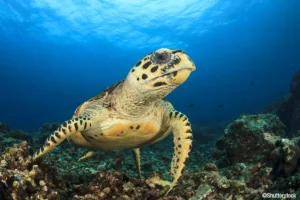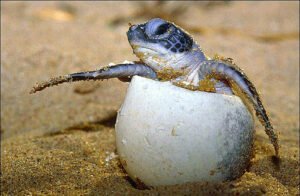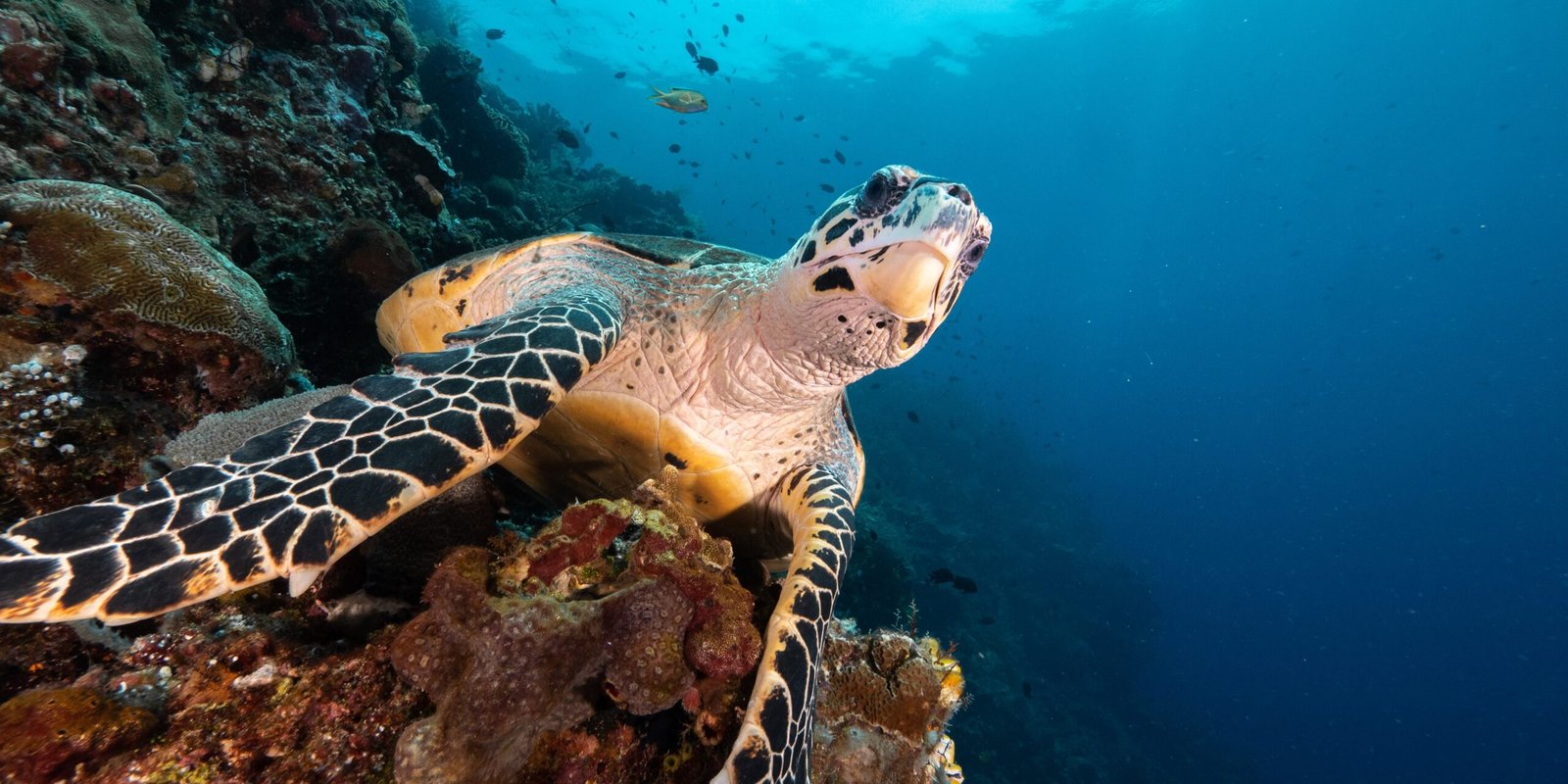The nesting behavior of the Hawkbill turtle is a remarkable sight to behold. After mating in the water, the female turtles make their way back to the same beach where they were born, using the Earth’s magnetic field as a guide. This incredible navigation ability allows them to return to their natal beaches, sometimes traveling thousands of miles.
Once the female turtle reaches the sandy beach, she digs a deep hole with her flippers and lays around 100 to 150 eggs. The temperature of the sand plays a crucial role in determining the sex of the hatchlings. Warmer temperatures result in more females, while cooler temperatures produce more males. This natural mechanism helps maintain a balanced population ratio.
After carefully covering the nest with sand, the female turtle returns to the ocean, leaving the eggs to develop and hatch on their own. The incubation period varies depending on the temperature, but it typically takes around 60 to 70 days. Once the hatchlings emerge from their shells, they instinctively make their way towards the ocean, guided by the moonlight reflecting on the water’s surface.
However, the journey from nest to sea is not an easy one for the tiny hatchlings. They face numerous obstacles, including predators such as birds, crabs, and even other turtles. The hatchlings’ small size and vulnerability make them an easy target for these opportunistic predators. Only a small percentage of hatchlings survive this treacherous journey, contributing to the already low survival rate of Hawkbill turtles.
As the surviving hatchlings enter the ocean, they begin their journey as part of the vast marine ecosystem. The young turtles spend several years floating in ocean currents, feeding on small invertebrates, and gradually growing in size. It is during this time that they develop their distinctive hawk-like beak, which gives them their common name.
As the Hawkbill turtles mature, they start to transition from their pelagic lifestyle to a more reef-associated one. They seek out coral reefs and lagoons, where they find an abundance of food and shelter. These habitats provide the perfect conditions for the turtles to thrive, offering protection from predators and a diverse range of food sources.
The importance of preserving the habitat of the Hawkbill turtle cannot be overstated. Coral reefs are facing numerous threats, including climate change, pollution, and overfishing. These factors not only directly impact the turtles themselves but also disrupt the delicate balance of the entire reef ecosystem.
Efforts are being made worldwide to protect and conserve the habitats of the Hawkbill turtle. Marine protected areas, strict regulations on fishing practices, and educational programs are just a few examples of the initiatives being implemented. By safeguarding their habitat, we can ensure the survival of this magnificent species for future generations to come.
Feeding Habits of the Hawkbill Turtle
As mentioned earlier, the Hawkbill turtle is primarily herbivorous, making it unique among sea turtles. Their beak-like mouth is perfectly adapted for their feeding habits, allowing them to easily scrape algae and other plant material off rocks and coral reefs.
These turtles play a crucial role in maintaining the health of coral reefs. By feeding on the algae that grows on the reefs, they prevent overgrowth, which can be detrimental to the coral. This symbiotic relationship between the Hawkbill turtle and the coral reef ecosystem highlights the importance of their conservation.
Although their diet mainly consists of plant material, Hawkbill turtles have been known to consume other marine organisms, such as jellyfish, small fish, and crustaceans. However, these instances are relatively rare and do not make up a significant portion of their diet.
It is fascinating to observe the feeding behavior of the Hawkbill turtle. When foraging for food, they use their powerful front flippers to navigate through the water with grace and agility. Their streamlined bodies allow them to move swiftly, making it easier for them to locate and consume their preferred food sources.
One interesting aspect of their feeding habits is their ability to detect the scent of their food. Hawkbill turtles have an acute sense of smell, which helps them locate patches of algae and other plant material from a distance. They can even detect the scent of a specific type of algae that they prefer, allowing them to be selective in their feeding choices.
Once they have located a suitable feeding spot, Hawkbill turtles use their beak-like mouth to scrape off the algae and other plant material from the rocks and coral reefs. Their beak is sharp and serrated, which enables them to tear through the tough outer layers of the plants and access the nutrient-rich interior.
While feeding, Hawkbill turtles also inadvertently help in the dispersal of plant seeds. As they scrape off the algae and other plant material, small fragments may break off and get carried away by the currents. These fragments can then settle in new areas, potentially leading to the growth of new plants and the expansion of the turtle’s feeding grounds.
Overall, the feeding habits of the Hawkbill turtle are not only fascinating but also vital for the health and balance of the coral reef ecosystem. Their herbivorous diet and unique feeding adaptations make them an important species to protect and conserve.
Life Span of the Hawkbill Turtle
The average lifespan of a Hawkbill turtle is estimated to be around 30 to 50 years in the wild. However, there have been reports of individuals living beyond 60 years. The exact lifespan can vary depending on various factors, including habitat conditions, predation, and human impacts.
One of the reasons why the Hawkbill turtle has a relatively long lifespan compared to other sea turtle species is its ability to adapt and survive in different environments. Their unique feeding habits and habitat preferences contribute to their longevity.
Unlike other sea turtles, the Hawkbill turtle has a specialized diet consisting mainly of sponges. This diet provides them with essential nutrients and allows them to thrive in coral reef ecosystems. The turtle’s beak-like mouth is perfectly adapted for reaching into crevices and extracting sponges, which are their primary food source. This specific feeding behavior not only contributes to their long lifespan but also plays a crucial role in maintaining the health of coral reefs.
Furthermore, the Hawkbill turtle’s habitat preference also contributes to its longevity. They are commonly found in tropical and subtropical waters, particularly in the Atlantic, Indian, and Pacific Oceans. These warm waters provide the ideal conditions for the turtle to grow and reproduce. The abundance of food sources, such as sponges and other invertebrates, ensures that they have a consistent supply of nutrients throughout their lives.
Unfortunately, the Hawkbill turtle is currently listed as critically endangered on the IUCN Red List of Threatened Species. This is primarily due to human activities, such as habitat destruction, poaching, and the illegal wildlife trade. Conservation efforts are crucial to ensure the survival of this magnificent species and protect its habitat.
In conclusion, the Hawkbill turtle is a remarkable species with a unique habitat preference and feeding habits. Their association with coral reefs highlights their importance in maintaining the health of these ecosystems. Understanding their habitat, feeding habits, and lifespan is essential for conservation efforts and raising awareness about the threats they face.
